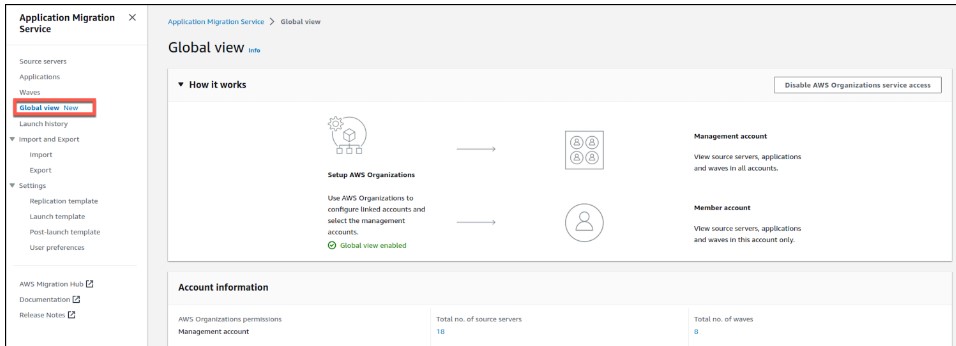This comprehensive article explores the major updates introduced in the AWS Application Migration Service (AWS MGN). AWS MGN is a fully managed service designed to facilitate the seamless migration of on-premises applications to the cloud. With its continuous evolution and enhancements, AWS MGN simplifies the migration process, reduces downtime, and enhances overall efficiency for organizations transitioning to cloud-based architectures. This report delves into the key features and functionalities of AWS MGN, highlights the latest updates, and discusses the benefits of these updates for organizations seeking to leverage the full potential of the cloud.
The rapid adoption of cloud computing has transformed the business landscape, prompting organizations to explore the migration of their on-premises applications to the cloud. In response to this growing demand, Amazon Web Services (AWS) introduced the AWS Application Migration Service (AWS MGN). AWS MGN is a fully managed service that facilitates the migration of applications, databases, and associated data from on-premises environments to AWS with minimal disruption and maximum efficiency.
The objective here is to delve into the major updates introduced in AWS MGN and explore how these enhancements have further improved the migration experience for businesses of all sizes. We will cover the core features and functionalities of AWS MGN, and then shift our focus to the latest updates, including global view import and export from local disks, additional post-launch actions, enhanced automation and customization, global application discovery, and improved user interfaces.
Overview of AWS Application Migration Service (AWS MGN):
AWS MGN is a comprehensive migration tool that enables organizations to migrate their applications and data to AWS without compromising on performance, security, or scalability. The core features of AWS MGN include:
- Server Migration: AWS MGN supports the migration of various types of servers, including physical, virtual, and cloud-based, to AWS. Organizations can migrate their applications running on Windows or Linux operating systems, and it is compatible with popular hypervisors such as VMware and Hyper-V.
- Agent-Based Replication: AWS MGN employs a lightweight, agent-based replication mechanism to capture and replicate data changes from the source servers to the target AWS instances. This ensures that the data remains consistent during the migration process.
- Cloud Native Replication: With cloud-native replication, AWS MGN can directly replicate data from the source storage to the target AWS instances without requiring additional on-premises infrastructure. This reduces migration complexity and minimizes downtime during the migration.
- Continuous Data Replication: AWS MGN offers continuous data replication, ensuring near-real-time synchronization between the source and target servers. This reduces the risk of data loss during migration and ensures data consistency.
- Traffic Routing: AWS MGN provides traffic routing capabilities, allowing organizations to control and manage user access to the source and target servers during the migration process. This helps minimize disruptions and ensures a smooth migration experience for end-users.
The global view:
The global view of AWS Migration Service provides organizations with a comprehensive and unified perspective on their application migration efforts across multiple geographic regions and data centers. As businesses increasingly adopt cloud-based solutions, managing migration projects spanning various locations becomes critical. The global view feature in AWS Migration Service addresses this challenge by offering a centralized dashboard that presents a holistic view of migration projects, status, and progress.

With the global view, organizations can gain valuable insights into the complexity of their application landscapes, identify interdependencies, and optimize migration strategies accordingly. This bird’s-eye view empowers stakeholders to make data-driven decisions, allocate resources effectively, and monitor the overall health of migration initiatives.
Moreover, the global view facilitates collaboration among teams working on different migration projects in diverse regions. It fosters a unified approach to migration planning and execution, enabling organizations to streamline processes, ensure consistency, and maximize efficiency.
Major Updates to AWS Application Migration Service:
-
Global View Import and Export from Local Disk:
The import and export of local disks with AWS Migration Service (AWS MGN) is a critical feature that simplifies the process of migrating large volumes of data from on-premises environments to the cloud. This capability allows organizations to seamlessly move their application data from local storage to AWS, reducing migration complexities and minimizing downtime during the transition.
Import from Local Disk:
The import feature in AWS MGN enables users to transfer application data from physical or virtual machines’ local disks to the AWS cloud. This is particularly beneficial when dealing with large datasets that may be impractical to transfer over the internet due to limited bandwidth or data size restrictions.
To initiate the import process, users need to prepare the data on their local disks and ship them to AWS. AWS provides secure data transfer appliances like AWS Snowball, which allows users to physically ship their data to an AWS data center. The data is then ingested into the target AWS environment, and the migration process can begin.
Export to Local Disk:
The export feature allows users to move application data from the AWS cloud back to local disks. This can be useful in scenarios where organizations need to keep a local copy of data for regulatory compliance, disaster recovery purposes, or other specific requirements.
Similar to the import process, users can use AWS Snowball or other relevant data transfer services to export data from AWS to their local storage. Once the data is exported, organizations can choose to maintain it locally or perform additional data processing tasks before finalizing the migration.
Benefits of Import and Export:
The import and export capabilities offered by AWS MGN present several advantages for organizations:
- Efficient Data Transfer: Importing data from local disks allows for more efficient and faster data transfer, especially when dealing with large datasets. This reduces migration time and minimizes application downtime during the transition.
- Data Security and Compliance: AWS MGN ensures data security during the import and export process. Data transfer appliances, like AWS Snowball, employ encryption and other security measures to safeguard sensitive data.
- Flexible Migration Options: The ability to export data back to local disks provides organizations with greater flexibility in managing their application data. It allows them to maintain copies of critical data on-premises for additional redundancy or compliance purposes.
- Seamless Data Replication: By combining import and export capabilities with other replication methods offered by AWS MGN, organizations can achieve seamless data replication between on-premises environments and the cloud, ensuring data consistency during migration and beyond.
-
Additional Post-Launch Actions:
Another significant update in AWS MGN is the inclusion of additional post-launch actions. During the migration process, post-launch actions play a crucial role in ensuring a smooth transition and operational readiness of applications in the cloud. The new update extends the range of post-launch actions available to users, providing more comprehensive control over application behavior after migration.
These post-launch actions encompass a wide array of tasks, such as system configuration, application setup, and network adjustments. By offering a broader selection of actions, AWS MGN facilitates the customization of migration workflows, enabling organizations to tailor the process to their specific requirements. This ultimately leads to a more efficient and successful migration outcome.
-
Enhanced Automation and Customization:
AWS MGN has been enriched with automation and customization features to streamline the migration process further. Users can now leverage pre-defined automation scripts and templates to automate various migration tasks, reducing the need for manual intervention and minimizing errors.
Automation not only expedites the migration process but also ensures consistency and reliability in the execution of migration tasks. By eliminating repetitive manual tasks, organizations can save time, reduce operational costs, and improve overall migration efficiency.
-
Global Application Discovery:
The addition of global application discovery is a game-changer for organizations planning large-scale migrations. This feature enables users to discover and assess their application portfolios across multiple geographic regions and data centers. With this comprehensive view, organizations can gain valuable insights into the complexity of their application landscape and identify potential dependencies, risks, and optimization opportunities.
Global application discovery empowers organizations to make data-driven decisions, allocate resources effectively, and create a migration strategy that aligns with business objectives. This visibility is essential for successful and well-informed migration planning.
-
Improved User Interface:
A user-friendly interface is critical to the success of any migration tool. AWS MGN has undergone significant improvements in its user interface, making it more intuitive, responsive, and efficient. The updated interface simplifies navigation, enhances user experience, and reduces the learning curve for new users.
A better user interface contributes to increased productivity, as users can easily access and manage their migration projects, monitor progress, and troubleshoot issues effectively. As a result, organizations can make the most of AWS MGN’s capabilities without facing barriers related to usability.
Benefits of AWS Application Migration Service Major Updates:
- Simplified Data Transfer: The ability to import and export data from local disks streamlines data transfer, reducing the complexity of migrating large datasets. This feature is particularly valuable for organizations dealing with extensive application data and limited network bandwidth.
- Enhanced Control: The additional post-launch actions provide more control over application behavior after migration, ensuring optimal performance and alignment with business needs. Organizations can fine-tune application configurations, automate certain tasks, and adjust settings based on real-time requirements.
- Time and Cost Savings: The automation and customization features lead to significant time and cost savings by automating repetitive migration tasks. Organizations can allocate resources more efficiently and reduce the need for extensive manual intervention, resulting in a more cost-effective migration process.
- Improved Planning and Decision-Making: Global application discovery empowers organizations with a comprehensive view of their application portfolios across regions, enabling better planning and resource allocation. Armed with this knowledge, organizations can prioritize migration efforts, identify dependencies, and optimize migration timelines.
- Better User Experience: The enhanced user interface ensures that users can navigate and operate AWS MGN with ease. Improved user experience translates to higher adoption rates and fewer support requests, making the migration process smoother and more efficient.
Conclusion:
The AWS Application Migration Service (AWS MGN) is a powerful tool that addresses the complexities of migrating on-premises applications to the cloud. With continuous updates and improvements, AWS MGN has evolved into a robust solution that simplifies the migration process, reduces downtime, and enhances overall efficiency for organizations of all sizes.
The major updates discussed in this report, including global view import and export from local disks, additional post-launch actions, enhanced automation and customization, global application discovery, and improved user interfaces, are testaments to AWS’s commitment to providing cutting-edge migration solutions.
As organizations continue to embrace cloud-based architectures, AWS MGN will play an increasingly vital role in facilitating smooth and efficient migrations to AWS. The AWS team’s relentless dedication to innovation and customer-centricity ensures that AWS MGN will remain at the forefront of migration services, empowering businesses to leverage the full potential of the cloud. Organizations seeking to migrate their applications to the cloud can confidently rely on AWS MGN to make their migration journey a success.
Source: Amazon Inc.
Reviewed By: TechWayMind Team…
